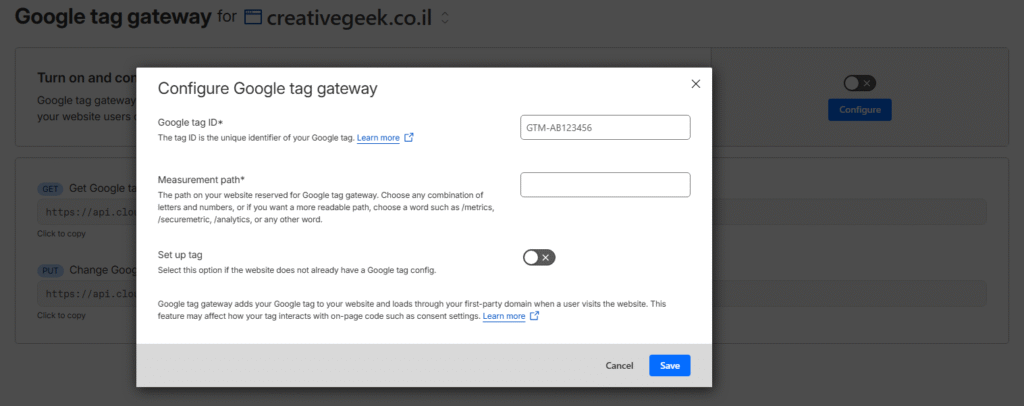I’ve been meaning to play around with the new Google Tag Gateway for a while now. It’s one of those quietly launched features that Google keeps hinting at in the GTM UI with subtle prompts — the kind that make you think, “alright, I should probably see what this is about.”
So I decided to dogfood it on my own blog, Tracking Chef.
And the results were… interesting.
TL;DR: I saw roughly an 8% uplift in measured sessions compared to a standard parallel GA4 setup.
What Is Google Tag Gateway?
Google Tag Gateway (GTG? GTagWay? still need a good acronym) is a relatively new feature in the tagging ecosystem that allows Google tags to load in a first-party context — essentially making them appear as if they’re being served directly from your domain.
Google frames it as a privacy and data governance enhancement, emphasizing “control” and “transparency.” But let’s be real — it’s also a clever workaround for ad blockers and Apple’s cookie restrictions in Safari and iOS.
By shifting how requests are routed, the Tag Gateway can restore some of the signal loss marketers have been grappling with since browser privacy measures tightened.
Implementation via Cloudflare
While there are multiple ways to implement the Tag Gateway, the Cloudflare integration is by far the simplest. If your DNS is already on Cloudflare, setup takes just a few clicks.
For my test, I used the GA4 integration, which injects an adjusted version of the GA4 script right into the top of the page’s <head> section.
This makes it dead simple to deploy — no coding, no custom domains, no special headers. But it does come with tradeoffs.

The Tradeoffs: Control vs. Convenience
The main downside of using Cloudflare’s GA4 integration is that you lose a fair bit of control:
- You can’t configure how or when the tag loads.
- You can’t easily tie it to consent conditions.
- You can’t move it lower in the page for better performance optimization.
It’s a “set it and forget it” approach.
But the upside is undeniable — an average 8% increase in measured sessions and events versus my standard GA4 implementation running in parallel. That’s a substantial gain if you’ve been watching your data slowly erode due to client-side blockers.

An Unexpected Perk: Cleaner Data
One interesting observation: the Gateway tag also seemed to filter out bot traffic that hit my site in August.
Some spammer apparently abused my GA4 Stream ID directly, flooding one property with fake traffic. The version running through Tag Gateway? Untouched.
That’s because the Gateway changes how requests are routed, making it harder for automated scripts to directly hit your measurement endpoint. So in addition to recovering lost signals, it might also reduce noise.
Next Experiment: GTM Through Tag Gateway
My next test is to run the entire GTM container through Tag Gateway rather than just GA4.
This approach should preserve full control over tags, triggers, and consent logic — while still giving all Google tags the benefits of a first-party context and an obfuscated request path.
There is, however, one small hiccup: Google’s script override leaves out the event: "gtm.js" initialization, which is crucial for firing subsequent tags inside GTM.
I manually added it, and so far, everything looks stable. If this setup continues to hold, it could be a really clean middle ground between client-side flexibility and server-side durability.

Final Thoughts
Google Tag Gateway isn’t a silver bullet, but it’s one of the most interesting developments in the post-cookie tagging era.
For sites where full Server-Side GTM is overkill — or too expensive to maintain — this could be a practical middle path. You get first-party context, improved measurement accuracy, and minimal setup overhead.
That 8% uplift might not sound huge, but in analytics terms, it’s the difference between guessing and knowing.
That said, if you’re looking for a more robust server-side solution, especially one that supports non-Google platforms (like Meta, TikTok, or custom APIs) in a first-party context, Stape is still the way to go. Their GTM Server hosting and integrations are far more flexible, production-ready, and enterprise-friendly compared to Google’s early-stage Gateway setup.
I’ll keep testing the GTM integration and post updates once there’s enough data to draw stronger conclusions.
Until then, if you’re running Cloudflare, give Tag Gateway a shot — and as always, dogfood responsibly.